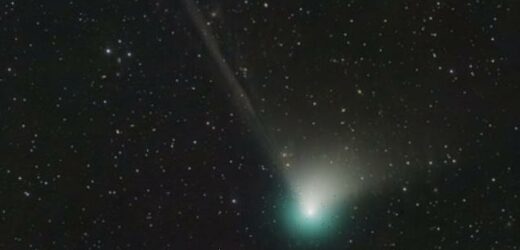Comet set to pass by Earth for the first time since Neanderthals existed 50,000 years ago is revealed in a new image
- A comet discovered in March made its last approach to Earth 50,000 years ago
- It is set to come within 26 million miles of Earth on February 1
- Astronomers shared a new image of the comet, revealing its coma and dusty tail for the first time
A comet not seen since Neanderthals walked the Earth is set to make a return trip – and astronomers have shared the first detailed image of the ‘cosmic snowball.’
Formally known as C/2022 E3 (ZTF), the comet orbits the sun every 50,000 years and is set to make its closest approach to our planet on February 1, 2023.
E3 was discovered in March, but scientists recently snapped the first detailed photo revealing its brighter greenish coma and a yellowy dust tail.
While the comet is too dim to see without a telescope, it should be visible to the naked eye when it is roughly 26 million miles away.
In early March, astronomers discovered Comet C/2022 E3 (ZTF) using the wide-field survey camera at the Zwicky Transient Facility.
Since then, the new long-period comet has brightened substantially and is now sweeping across the northern constellation Corona Borealis in predawn skies.
A blazing comet that has traveled for 6,800 years was seen streaking over Stonehenge on a perfect summer’s evening in 2020.
The comet is currently 117 million miles from Earth and is set to reach the sun on January 1, loop around and make its closest to our planet.
And E3 will be the first comet seen to the naked eye since the NEOWISE comet in July 2020.
However, NEOWISE left a long, misty tail and E3 is likely to appear as a grey streak in the night sky.
E3 should be visible by January 26 but reach its brightest on February 1.
This comet is not the only cosmic display set for 2023, as the year will kick off with the annual Quadrantids meteor shower and will end with the impressive Geminid meteor shower in December.
The Quadrantid is one of the year’s most spectacular meteor showers, and you do not need specialist equipment to see it.
While the meteor shower technically began today, it will reach its peak on the night of January 3 and the morning of January 4.
It is an above-average shower, which usually sees 40 meteors pass per hour.
At an extreme, however, up to 200 shooting stars can be seen per hour, but that relies on perfect conditions in the ideal spot on Earth.
And as 2023 comes to a close, the Geminid meteor shower will light up the sky from December 13 to 14.
The comet is currently 117 million miles from Earth and is set to reach the sun on January 1, loop around and make its closest to our planet
This comet is not the only cosmic display set for 2023, as the year will kick off with the annual Quadrantids meteor shower and will end with the impressive Geminid meteor (pictured) shower in December
The meteors are mainly white but can also be yellow, green, red or blue.
While comets cause most meteor showers, the Geminid meteor shower is unique as the shower is produced as the Earth passes through a trail of debris created by an asteroid known as 3200 Phaethon.
Head to a dark area, away from light pollution, and allow at least 30 minutes for your eyes to adjust to the night sky.
The Geminid meteor shower was first reported in 1862, but it was not until 1983 that scientists determined 3200 Phaethon was the source.
It is called the Geminids because when Earth passes through the debris, it lights up the Castor star in the Gemini constellation.
If you enjoyed this article…
Comet ATLAS may be a remnant of a mysterious fireball that swept within 23 million miles of the sun 5,000 years ago, study finds
Dinosaurs were wiped out by a COMET that ‘pinballed’ off Jupiter before slamming into Earth 66 million years ago – and NOT an asteroid, scientists claim
Bright green iceball that once came within 7.1 million miles of Earth is found to contain ‘abnormally high’ levels of ALCOHOL
Source: Read Full Article





